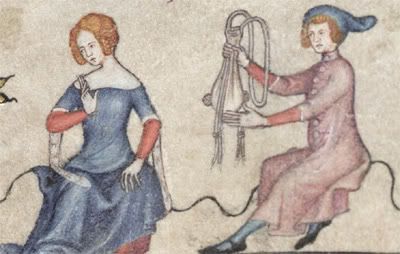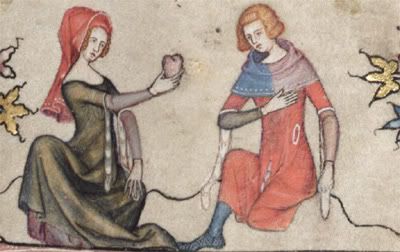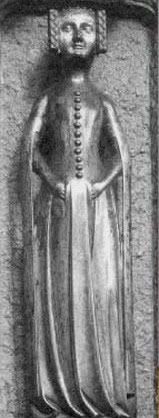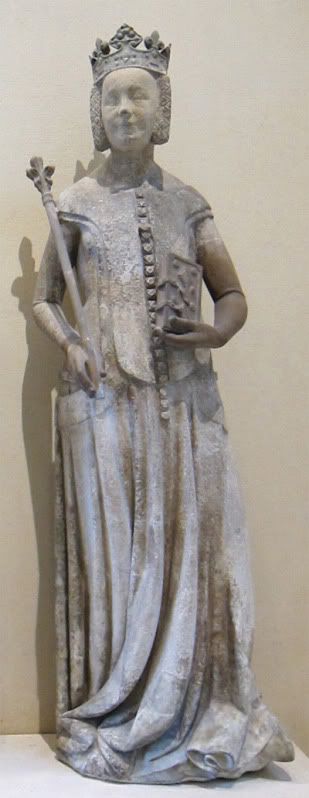Head to Toe: A 14th Century Woman
1:10 AMThe 14th century is really when fashion began to pick up. The lower classes are beginning to try to imitated the upper classes so to keep some semblance of social order sumptuary laws are passed, dictating which classes can wear what. But then people began to modify their dress to get around the laws, and fashion really begins.
Hairstyles and headwear began to get more complex in the 14th century. Women could wear a wimple or head veil, or for outdoors activities a hood or hat similar to what a man might wear. Hair was parted in the center and styled into two long braids which could be coiled over the ear or draped forward in front of the ear and then brought back to the crown of the head. These 'dos could then be topped with a jeweled mesh cage or wire-framed net called a crespine.

An image from Bodleian Library MS Bodl. 264, a mid-fourteenth-century edition of the Romance of Alexander, showing an elaborate hairstyle.
A ladies wardrobe starts with a chemise, a simple linen garment which had a variety of necklines, from the low cut to the high necked. Her legs would be covered with hose with hose which came in a variety of colors and were secured above the knee with garters.

Detail of February from Les Très Riches Heures du Duc de Berry, 1412. A lower class woman warms her legs, showing off her hose.
Now for the garment people would actually see. Fabric and therefore clothing was extremely expensive, so if you could afford to wear multiple layers you wanted to show that off. The main garment worn by women was the cotehardie, a tightly fitted gown with a low waistline and a wide, scooped neckline. The tight fit was achieved by buttons or lacing up the sides or front. To showcase your wealth with multiple layers of clothing, wealthier women wore a kirtle, a tight fitting garment, underneath their cotehardies. To show off the kirtle underneath cotehardies could be slit down the sides, or for unslit versions the kirtle could show at the neckline and cuffs.

Another image from Bodleian Library MS Bodl. 264, a mid-fourteenth-century edition of the Romance of Alexander. The woman, so romantically giving away her heart, wears a purple kirtle and green cotehardie.
The sleeves would end at the elbow have a sort of tail coming off of them, called a lappet (if the tail was made out of the extra fabric) or a tippet (if the tail was a separate piece of fabric attached to the sleeve). Gowns were long and dragged on the floor, another way to show off wealth. Because if your dress is that long it means you aren't working, just sitting around and looking pretty. Fitchets were slits made in the garment so that a lady could reach inside for her purse. Consider fitchets the precursor to the pocket, which wouldn't arrive for several more centuries.

Statue of Joan de la Tour from 1377. She wears a cotehardie with lappets, and has her hands tucked into her fitchets.
Another option for women was the sideless surcoat, a decorative overgown with enormously long armholes, making the gown basically sideless. The Church did not approve, calling these slits the windows to hell. As the century progressed the band of fabric in the middle became narrower and narrower. A plastron, a stiffened and highly decorated piece of fabric, could be added to the front and back of the garment for some pizazz. The sideless surcoat quickly moved to being a ceremonial garment, leaving the cotehardie as the main fashion choice for women.

Statue of Jean of Bourbon from 1364-1380. She wears a sideless surcoat with a plastron.
It's hard to know what shoes women wore, as their feet rarely show in images from the period. But when feet do show, women seem to be wearing pointy toed shoes similar to what men wore, called crackowes or poulaines.
Special thanks to Got Medieval, a fabulous history blog with a wealth of medieval images for me to kindly borrow (no but seriously, do you know how hard it is to find 1. Medieval images and 2. Medieval images with reliable date and source information?). Go visit it and see more medieval fashion! Also monkeys.



20 comments